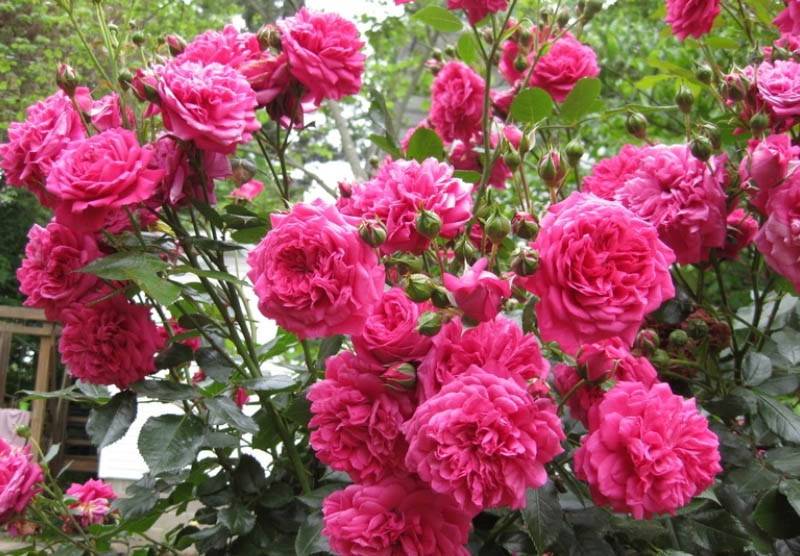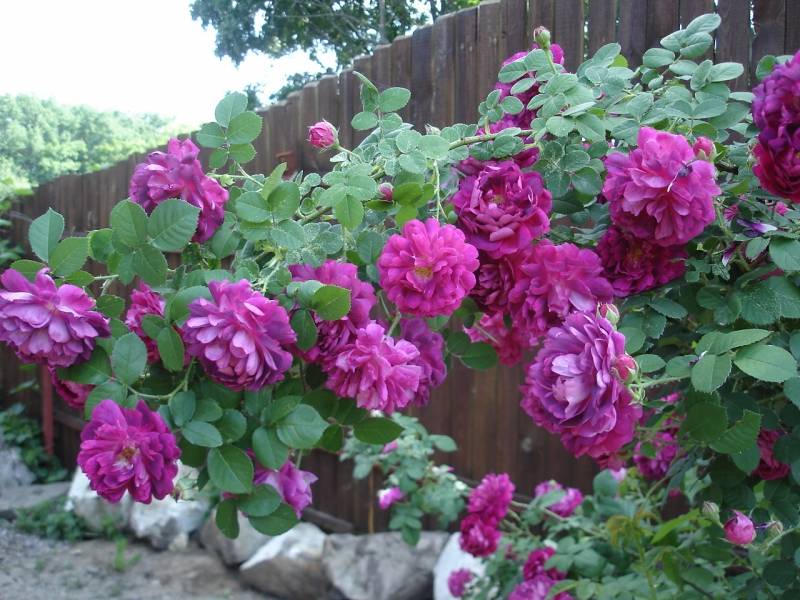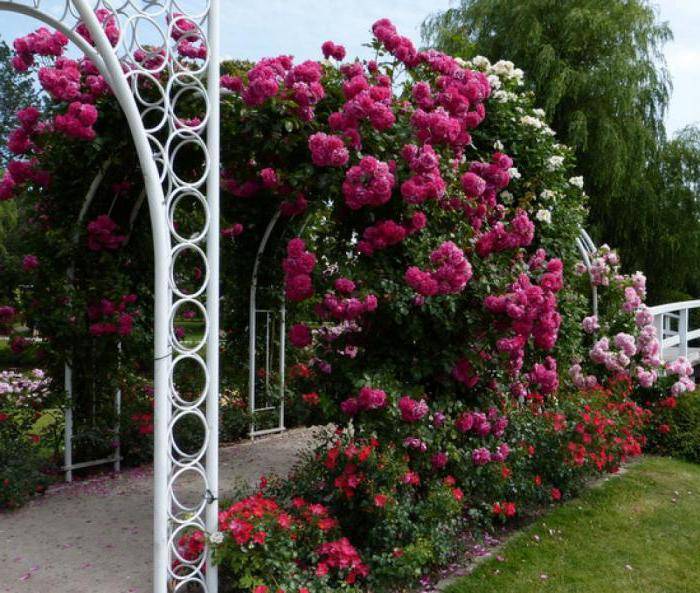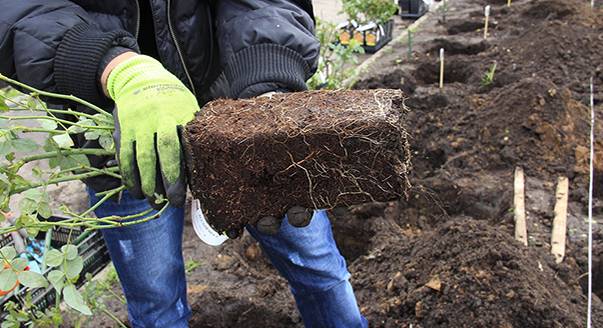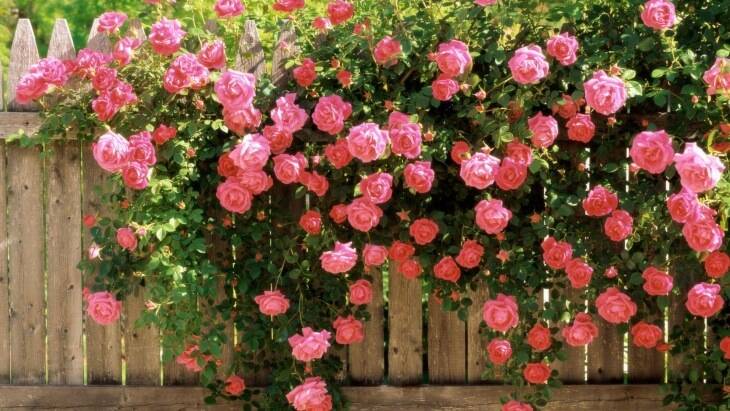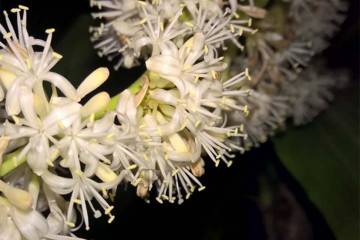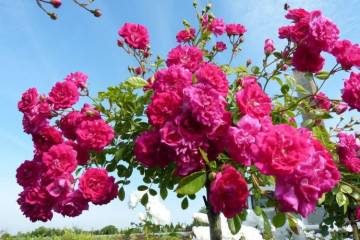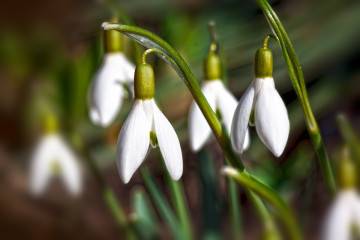Rose Laguna (Laguna) - what kind, what types are there
Content:
Among the many park and garden flowers, the rose stands out strikingly. There are a great many types and varieties of rose bushes, but among them it is impossible not to notice the Lagoon. Rose Laguna will captivate with its aroma, lush, delicate buds and long shoots that rise several meters.
Rose Laguna (Laguna) - what kind of variety, history of creation
Laguna is a weaving variety with a stem height of up to 2.5 m. The variety was bred by Wilhelm Cordes & Sons in 2004, which has been breeding new varieties for 2 centuries. They set themselves the goal of creating not only a beautiful, but also a hardy flower that is resistant to diseases, weather conditions and parasites.
Their idea was completely successful - all the best qualities inherent in rose bushes were combined in the Lagoon.
Brief description, characteristic
Laguna rose has the following description:
- the height of the shoots is from 1.8 to 2.5 m, the branches are straight;
- leaves are green, dense, with a glossy surface, of medium size;
- the buds are large, the shape is pointed to the top, the color of the petals is rich shades of a mixture of red and crimson;
- the diameter of the opened bud is 10 cm.
Each bud consists of 50-60 petals.
Varieties Blue and Sweet
The variety has two subspecies - Blue Lagoon rose and Sweet.
Rose Blue Lagoon will suit lovers of exotic. Its petals are painted in an unusual shade of purple. It is distinguished not only by its non-standard color, but also by the shape of the buds - the inflorescences are lush, but the flowers themselves are semi-double. Unlike the classic Lagoon, they have fewer petals, and the core is yellow.
Sweet was launched in 2012. The flower took the best from the mother variety, and in addition to excellent characteristics - an amazing aroma of flowers. It combines notes of patchouli, geranium and lemon. Svita's flowering is delicate pink.
Advantages and disadvantages of the variety
The Laguna rose is loved by gardeners, both experienced and beginners, for a number of its advantages:
- abundant and prolonged flowering, flowers practically cover the foliage;
- unpretentious care;
- resistance to pests, diseases and different weather conditions;
- aroma - strong, rich;
- rapid development of the bush;
- maximum resistance to prolonged and heavy rainfall;
- fading is practically absent.
The only drawback of the rose is the presence of a large number of thorns, sharp and strong.
Use in landscape design
Climbing rose Lagoon is the queen of any garden and suburban area.It looks great in solo landing and in combination with other colors of all kinds of colors. Supports, arches are made for it, used to decorate gazebos and verandas.
Growing a flower, how to plant it in open ground
The hybrid variety Laguna is an unpretentious rose in care and planting. But still there are a number of rules and recommendations that must be followed when growing rose bushes.
In what form is the landing
Rose planting is carried out by seedlings. The seed method is not used, since it does not convey the characteristics of the variety.
What time is the boarding
You can plant a rose in autumn or spring. The main condition for a successful planting is the absence of frost and the warming up of the soil to a temperature of 10 ° C to 12 ° C.
Location selection
The rose loves a lot of sunlight, but not the direct rays that burn the foliage. The best place for her is partial shade. If groundwater passes through the site, the distance from them to the roots should be at least 1 m. It is necessary to plant a rose near the wall of the house so that rainwater flowing from the roof does not fall on it.
How to prepare the soil and flower for planting
The rose needs a nutritious and loose soil, light, allowing enough moisture and air to pass through. You can prepare the soil yourself by mixing the following ingredients:
- 10 g of garden soil;
- 10 kg of sand;
- 5 kg of peat;
- 400 g of wood ash;
- 400 g of complex mineral fertilizer.
The roots of the seedling are examined, bad parts are removed. He is dipped for 2 hours in a solution of 1 part clay and 2 parts mullein.
Planting procedure step by step
Planting a seedling is carried out according to the following technique:
- Dig a hole, diameter 60 cm, depth 50 cm.
- Install a net or trellis so that in the future, the shoots will spread upward. There must be at least 10 cm between the rose and the support.
- Water the soil abundantly.
- Insert the seedling only after all the water has been absorbed. The roots of the plant must be placed evenly over the hole.
- Cover with soil, compact slightly.
Finally, water, mulch.
Picture 4 For planting, you need to choose high-quality seedlings with a good root system
Plant care
The climbing tea Lagoon is an unpretentious plant that does not require complex and specific conditions. Both an amateur and a novice gardener can take care of her.
Watering rules and humidity
In the first year after planting, watering is carried out 1 time in 4 days. In the future, watering is enough for the rose 1 time in 10 days, provided there is no rain. It is important to monitor the condition of the soil around the flower - it should not completely dry out. Watering is carried out in the morning or in the evening, when there is no strong sun. Water is poured directly into the roots; it cannot be poured onto the leaves.
Humidity is moderate. A large amount of moisture can rot the roots.
Top dressing and soil quality
The soil should be nutritious, enriched with minerals. Organic fertilizer is applied before planting the seedling. In the second year of growth, mineral mixtures are added 4 to 5 times.
Before the beginning of the growing season, nitrogen is added, in the middle of the period - potassium and phosphorus, at the end - potassium fertilizers. Organic fertilizers are used twice a year.
Pruning and replanting
Pruning is done the next year after disembarkation. Bad, damaged shoots, frozen branches are removed. After winter, high pruning is carried out - the branches are cut high above the ground.Based on the size of the bush, it is enough to leave about 7 branches 2-3 years old and several young shoots.
If it is necessary to transplant a bush, it must be carefully dug up, a clod of earth on the roots should be kept, transplanted into a new hole with fertile, fertilized soil.
Features of wintering a flower
Long shoots are removed from the supports and placed on the ground. Closed from above with breathable fabric, spruce branches or boards are placed on it.
Blooming rose
The lagoon blooms in two long waves throughout the season.
Flower activity begins in May - June, depending on the region. The dormant period begins around September - early October.
Care during and after flowering
In the active period, the rose only needs proper watering and pruning of wilted buds. After flowering, the rose must be fed, damaged branches removed, and prepared for winter.
What to do if it does not bloom, possible reasons
Weak flowering or its absence can be caused by poor soil, improper watering, lack of sanitary pruning. You can improve flowering by restoring proper care.
Flower propagation
Reproduction of the Lagoon is carried out by cuttings. The optimal time for this is September-October.
Detailed description
Cuttings can only be cut from faded branches; each shoot must have at least 1 internode. Procedure:
- Make a section under the lower kidney at an angle of 45 °, the second cut at as much distance from the kidney as possible.
- Remove the lower leaves.
- Add sand to the soil.
- Lower the stalk into the ground to a depth of 2 cm.
- Cover with a plastic bottle or glass jar.
After planting, the cutting should be watered periodically - the ground should not dry out.
Diseases, pests and ways to control them
Due to excessive moisture in the soil, the roots of the rose can rot. The rose has no predisposition to any diseases.
Pests are aphids and spider mites. To combat them, insecticides are used, such drugs as Actellik, Fufanon will help to remove aphids.
The lagoon is the most beautiful climbing rose, a bright decoration of the garden and suburban area. It is picky, easy to care for and easy to reproduce. For those who want to highlight their garden and give it a zest, it is recommended to plant the Blue subspecies, with an unusual purple shade of delicate petals.
